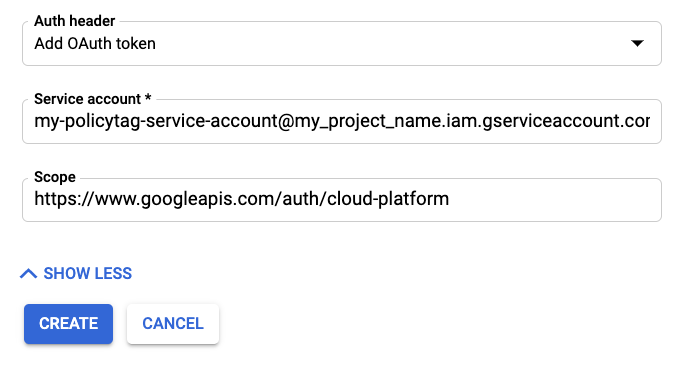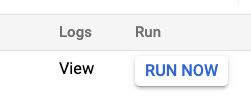Managing policy tags across locations
This document describes how to manage policy tags across regional locations for column-level security and dynamic data masking in BigQuery.
BigQuery provides fine-grained access control and dynamic data masking for sensitive table columns through policy tags, supporting type-based classification of data.
After creating a data-classification taxonomy and applying policy tags to your data, you can further manage the policy tags across locations.
Location considerations
Taxonomies are regional resources, like BigQuery datasets and tables. When you create a taxonomy, you specify the region, or location, for the taxonomy.
You can create a taxonomy and apply policy tags to tables in all regions where BigQuery is available. However, to apply policy tags from a taxonomy to a table column, the taxonomy and the table must exist in the same regional location.
Although you cannot apply a policy tag to a table column that exists in a different location, you can copy the taxonomy to another location by explicitly replicating it there.
Using taxonomies across locations
You can explicitly copy (or replicate) a taxonomy and its policy tag definitions to additional locations without having to manually create a new taxonomy in each location. When you replicate taxonomies, you can use the same policy tags for column-level security in multiple locations, simplifying their management.
When you replicate them, the taxonomy and policy tags retain the same IDs in each location.
The taxonomy and policy tags can be synced again, to keep them unified across multiple locations. Explicit replication of a taxonomy is accomplished by a call to the Data Catalog API. Future syncs of the replicated taxonomy use the same API command, which overwrites the previous taxonomy.
To facilitate syncing of the taxonomy, you can use Cloud Scheduler to periodically perform a sync of the taxonomy across regions, either on a set schedule or with a manual button push. To use Cloud Scheduler, you need to set up a service account.
Replicating a taxonomy in a new location
Required permissions
The user credentials or service account replicating the taxonomy must have the Data Catalog Policy Tags Admin role.
Read more about granting the Policy Tags Admin role in Restricting access with BigQuery column-level security.
For more information on IAM roles and permissions in BigQuery, see Predefined roles and permissions.
To replicate a taxonomy across locations:
API
Call the
projects.locations.taxonomies.import
method of the Data Catalog API, supplying a POST request and
the name of the destination project and location in the HTTP string.
POST https://datacatalog.googleapis.com/{parent}/taxonomies:import
The parent path parameter is the destination project and location
that you want to copy the taxonomy to. Example:
projects/MyProject/locations/eu
Syncing a replicated taxonomy
To sync a taxonomy that's already been replicated across locations, repeat the Data Catalog API call as described in Replicating a taxonomy in a new location.
Alternatively, you can use a service account and Cloud Scheduler to sync the taxonomy on a specified schedule. Setting up a service account in Cloud Scheduler also lets you trigger an on-demand (unscheduled) sync through the Cloud Scheduler page in the Google Cloud console or with Google Cloud CLI.
Syncing a replicated taxonomy with Cloud Scheduler
To sync a replicated taxonomy across locations with Cloud Scheduler, you need a service account.
Service accounts
You can grant permissions for the replication sync to an existing service account, or you can create a new service account.
To create a new service account, see Create service accounts.
Required permissions
The service account that is syncing the taxonomy must have the Data Catalog Policy Tags Admin role. For more information, see Grant the Policy Tags Admin role.
Setting up a taxonomy sync with Cloud Scheduler
To sync a replicated taxonomy across locations with Cloud Scheduler:
Console
First, create the sync job and its schedule.
Follow the instructions to Create a job in Cloud Scheduler.
For Target, see the instructions at Creating a scheduler job with authentication.
Next, add the authentication needed for the scheduled sync.
Click SHOW MORE to display the authentication fields.
For Auth header, select "Add OAuth token".
Add your service account's information.
For the Scope, enter "https://www.googleapis.com/auth/cloud-platform".
Click Create to save the scheduled sync.

Now, test that the job is configured correctly.
After the job is created, click Run now to test the job is configured correctly. Subsequently, the Cloud Scheduler triggers the HTTP request based on the schedule that you specified.

gcloud
Syntax:
gcloud scheduler jobs create http "JOB_ID" --schedule="FREQUENCY" --uri="URI" --oath-service-account-email="CLIENT_SERVICE_ACCOUNT_EMAIL" --time-zone="TIME_ZONE" --message-body-from-file="MESSAGE_BODY"
Replace the following:
${JOB_ID}is a name for the job. It must be unique in the project. Note that you cannot re-use a job name in a project even if you delete its associated job.${FREQUENCY}is the schedule, also called job interval, of how often the job should run. For example, "every 3 hours". The string that you supply here can be any crontab-compatible string. Alternatively, developers familiar with legacy App Engine cron can use App Engine Cron syntax.${URI}is the fully qualified URL of the endpoint.--oauth-service-account-emaildefines the token type. Note that Google APIs hosted on*.googleapis.comexpect an OAuth token.${CLIENT_SERVICE_ACCOUNT_EMAIL}is the email of the client service account.${MESSAGE_BODY}is the path to the file that contains the POST request body.
Other option parameters are available, which are described in the Google Cloud CLI reference.
Example:
gcloud scheduler jobs create http cross_regional_copy_to_eu_scheduler --schedule="0 0 1 * *" --uri="https://datacatalog.googleapis.com/v1/projects/my-project/locations/eu/taxonomies:import" --oauth-service-account-email="policytag-manager-service-acou@my-project.iam.gserviceaccount.com" --time-zone="America/Los_Angeles" --message-body-from-file=request_body.json
What's next
- For an overview of column-level security with policy tags, see Introduction to BigQuery column-level security.
- For more information about creating and applying policy tags, see Restricting access with BigQuery column-level security.
- To learn about the impact to writes when you use BigQuery column-level security, see Impact on writes with BigQuery column-level security.
- For information about best practices for using policy tags, see Using policy tags in BigQuery.
